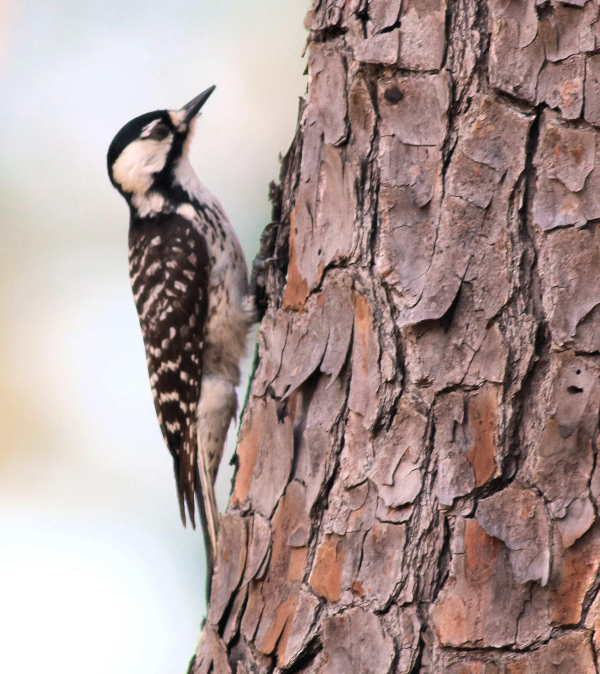
Red-cockaded Woodpeckers typically live in family groups that have a cooperative nesting system and retain long-term territories (photo by Paul Konrad).
|
Last week the US Fish & Wildlife Service downlisted the Red-cockaded Woodpecker from Endangered to the lesser status of Threatened under the Endangered Species Act. Red-cockaded Woodpeckers are a unique territorial, non-migratory social species that live in family groups called clusters in mature pine forests in the southeast United States. The milestone of downlisting is the result of 5 decades of collaborative conservation work and today the Service estimates there are 7,800 clusters ranging across 11 states from southern Virginia to east Texas.
Once common from New Jersey to Florida and west to Texas, Arkansas, and Missouri, the range of Red-cockaded Woodpeckers was reduced to a few states by the 1960s, following more than a century of habitat loss. Listed as an endangered species in 1973, populations were at an all-time low during the late 1970s when only 1,470 clusters were estimated across their reduced range.
Red-cockaded Woodpecker family groups (clusters) have a cooperative nesting system and retain long-term territories. These unique woodpeckers typically excavate nesting and roosting cavities in live trees, and the cavities may be used for decades. Above and below each cavity entrance this species of woodpecker pecks tiny holes that become “resin wells.” Resin exudes from the live tree to form a sticky mass on the bark surrounding the cavity entrance with the apparent effect of protecting the birds and their nest sites from climbing rat snakes and other predators.
“The downlisting of the Red-cockaded Woodpecker marks a significant milestone in our nation’s commitment to preserving biodiversity,” said Interior Secretary Deb Haaland. “Through decades of collaborative efforts from a wide coalition of partners, we have brought this iconic species back from the brink of extinction, ensuring that future generations will continue to see these incredible birds thriving in their natural habitats. This is another important accomplishment in the U.S. Fish and Wildlife Service’s implementation of the iconic Endangered Species Act.”
Since being listed as an endangered species, Red-cockaded Woodpeckers have benefited from active conservation efforts from conservation partners and private landowners. For example, state-wide Safe Harbor Agreements have enrolled 459 non-federal landowners that manage approximately 2½ million acres, resulting in an increase in Red-cockaded clusters on state and private lands during the past 30 years.
“Decades of committed recovery work and collaboration drove this remarkable story of recovery,” said Service Director Martha Williams. “The Service worked closely with the Departments of Agriculture and Defense, private landowners, Tribes, state agencies, businesses, utilities, and conservation groups to reach today’s announcement. The improved status of the Red-cockaded Woodpecker shows that when we give species a chance, they can thrive. The Endangered Species Act can serve as a catalyst for collaborative efforts like this one to promote species recovery and conserve habitats.”
While the Red-cockaded Woodpecker’s status has improved, the species has not fully recovered and remains a threatened species. They continue to be at risk of becoming endangered again due to habitat loss, events like hurricanes, ice storms, and wildfires as well as the challenges posed by small population sizes. Therefore, the US Fish & Wildlife Service will continue working with its coalition of partners to help Red-cockaded Woodpeckers thrive and advance toward a full recovery.
To refer to the US Fish & Wildlife Service news release, see Downlisting of Red-cockaded Woodpecker from Endangered to Threatened | U.S. Fish & Wildlife Service (fws.gov)